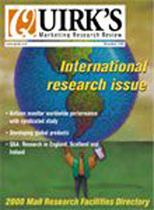Editor’s note: Bill MacElroy is president of Modalis Research Technologies, Inc., San Francisco.
Judging by the interest in the topic of Web surveying at the recent ESOMAR Congress 2000 in Vienna, there is little doubt that research on the Web has arrived well beyond the shores of North America. Just as it has been in the U.S., the reaction to the use of the Web in many international regions is going through phases.
First, there tends to be resistance to online research due to fear that sampling may be uncontrolled or non-representative and therefore yield bad or unpredictable results. For many countries where the Internet penetration has exceeded 20 percent, the preponderance of evidence suggests that online samples tend to yield very similar results to those found in traditional forms such as telephone or paper-and-pencil survey research. In addition, the low response rate and lack of cooperation found in traditional methods in North America is now impacting survey research the world over – blunting criticisms of Web sampling somewhat. (Of all the people I spoke with at the ESOMAR conference, there was only one person, a delegate from South Africa, who said that survey response rates employing traditional methods are still as high as they were five years ago.) We estimate that most of the world is still in this phase of pre-acceptance of the Web as a sole information gathering tool.
Secondly, there tends to be a resistance (on behalf of corporate clients) to invest in the experimentation with new technology. Many clients fear that relying on results derived from surveying on the Web will be dangerous without up-front side-by-side studies to provide a proof-of-concept. Such efforts are considered costly (in terms of both time and money) and experimental. This appears to be the stage of acceptance in most of Europe at this time.
Recent survey results released by industry newsletter Inside Research show that on a percentage of total research expenditures, Europe trails the U.S. in acceptance by about 12 to 18 months, assuming that the region follows the same growth curve as the U.S. That growth appears to be on track, or perhaps even faster than the original growth in the U.S., in several countries, including Germany, the U.K., and Scandinavia.
The next phase of acceptance has to follow the general population’s (either business or consumer) adoption of the Web as a significant communication and transactional medium. The greatest barriers seem to exist here, particularly when e-commerce or transaction-based research is concerned. One of the great points of divergence between North America and the rest of the world is the cultural orientation to credit.
Last fall, I attended a wonderful IIR Internet Research conference in Helsinki, Finland. Finland is the country with arguably the highest per capita Internet access in the world. The attendees were very sharp and completely up-to-date on the latest Web-based technologies and research applications. Although the proportion of activities that the Finnish population does online is high, the level of transactions they conduct is incredibly small in comparison to the U.S. The explanation for this surprised me. The use of credit cards is not a large part of the Finnish culture. Even in Germany, the Internet powerhouse of Europe, the cultural trend has been to adopt debit cards rather than credit cards. This slows down the verification process and makes it more difficult to ship on demand.
Indeed, as one begins to consider regional aggregations (e.g., Europe, Asia, etc.) the profound differences in culture, attitudes and technology-adopting characteristics from country to country lead me to conclude that such multi-country aggregations are fictitious, at least for online research planning purposes. In my opinion, there is no such thing as the “state of research in Europe.” The European countries and their development are just too different from one another and are diverging rapidly.
Now this is not to say that one country is better than another; they are just different. Compare Germany and Italy, for example. Germany has, in many ways, leapfrogged the U.S. in terms of the construction of the Internet infrastructure. They may not have as many people online per capita, but the vast majority of those who are connected have a minimum of an ISDN connection with the very latest browsers. Italy, which does not have the optical-cable installation infrastructure, is rushing to adopt wireless technology, perhaps taking the lead in the latest forms of connectivity. Each country’s unique characteristics have a tremendous influence on how research will be conducted and the types of research that will emerge.
Although I have been commenting primarily on the U.S. and Europe, I would be remiss in not mentioning that several Asian and South American countries are coming up to speed very quickly, both in infrastructure and in attitudes towards the use of the Web for research. The influence of openness to adopt the use of the Internet for Web research cannot be underestimated in terms of its potential for the global expansion of online research services.
In summary, it is my opinion that a number of issues will influence the growth of Web-based research in the next five years. These include not just the technology infrastructure and the proportion of the population with Internet access, but also the cultural orientation of both the customer populations and the firms commissioning such research. The interplay of these variables may yield some very surprising results when we review the proportion of research budgets being devoted to Web-based research at the end of that period.
